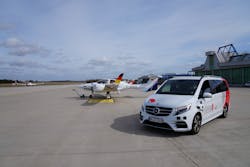Robotaxi for the Apron: Successful Project Completion by Lidar Specialist Ibeo, the Christian-Albrecht University of Kiel and Airbus Operations
Hamburg/Rostock, March 2022 – After around three years of research and development, Hamburg-based lidar specialist Ibeo Automotive Systems GmbH, together with the Christian-Albrecht University of Kiel (CAU) and Airbus Operations, has successfully completed the AirPortMover project with a live presentation at the GATE InnoAirport Rostock-Laage. The project, which was funded by the German Federal Ministry of Economics and Climate Protection, focused on the driverless transport of people, such as aircraft crews, on the taxiway or apron.
As a specialist for lidar sensors, the associated software, and accompanying systems, Ibeo Automotive Systems GmbH is playing a decisive role in shaping the future of mobility. Relevant for the global innovation leader are solutions for individual road traffic as well as for logistics, rail, or self-contained environments such as airports. As the scientific center of Schleswig-Holstein, Kiel University has dedicated itself, among other things, to questions concerning the sustainable and innovative development of mobility. A key aspect of the introduction of autonomous means of transport is their safe operation and high degree of trustworthiness. The “Reliable Systems” working group, headed by Professor Dirk Nowotka, is addressing this project topic in particular against the background of approval procedures.
Airbus accompanied the project with important information on the topics of process flows on the airport apron, requirements for communication between the airport tower and the autonomous vehicle, and the infrastructure needed for this.
The innovation platform GATE InnoAirport provided a test environment under real conditions for the project at Rostock-Laage Airport.
With a successful project conclusion on the airport grounds, the project partners demonstrated solutions for fully autonomous driving vehicles under the special challenges and safety conditions of an airport apron.
“Since the project started in 2018, technology has advanced at a rapid pace. That was very exciting, but also a real challenge. In the sensor area, for example, we relied on a combination of Ibeo’s solid-state lidar sensors and cameras right from the start,” says Max Stehn, who was responsible for the project as Autonomous Driving Project Manager for Ibeo. “Solid-state sensors are much more compact and require less maintenance than conventional lidar sensors and have no moving parts. At the same time, they offer greater vertical coverage of the environment, which means that they also reliably detect objects positioned higher than themselves – such as aircraft tail units. With the ibeoNEXT sensors, we have implemented 360-degree coverage to detect both static and dynamic obstacles around the vehicle. This is especially important when approaching an aircraft.”
“Milestone on the road to airport process automation”
There would nevertheless still be challenges with regard to the large amount of data that has to be processed in real time and then passed on to the respective vehicle functions. “However, with the rapid evolution of computing power and possible shifts of computing power to the cloud, these technical hurdles can in all likelihood be addressed,” adds Stehn.
A live presentation on site showed how well the system works, with an equipped Mercedes V-Class maneuvering various test candidates fully autonomously across the tarmac to different aircraft models.
“As a team, we have proven that today’s technology is capable of safely and reliably overcoming the complex challenges of object location in the smallest of spaces. This is achieved, for example, on the apron, where shuttle vehicles are brought up to aircraft. I am sure that we and the project partners will gain further important insights in this area and from this project in the near future,” says Professor Dirk Nowotka from the Christian-Albrecht University of Kiel.
“As an idea generator for global air travel and an innovation driver for airport operations, our focus is on the passenger’s comfortable and sustainable journey with baggage – from arrival at the airport and time spent there to boarding and deplaning, including transfers – as well as the efficient transport of cargo. Automation enables just that – and in many areas. In the case of the AirPortMover, an important safety component is added: Here, automation decouples mobility in a safety-relevant area from human weaknesses, such as short-term inattention. On behalf of the entire team, I am very proud to have been able to give this important project an appropriate stage here at the GATE InnoAirport site,” concludes Kevin Fischer, Innovation Manager of GATE, the association of airport equipment suppliers.
